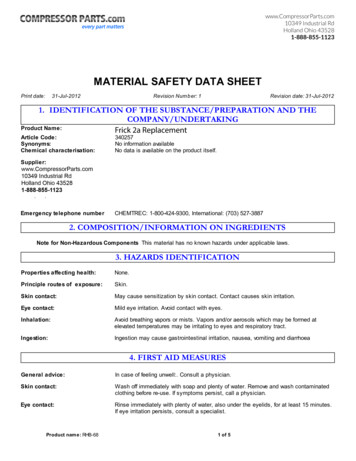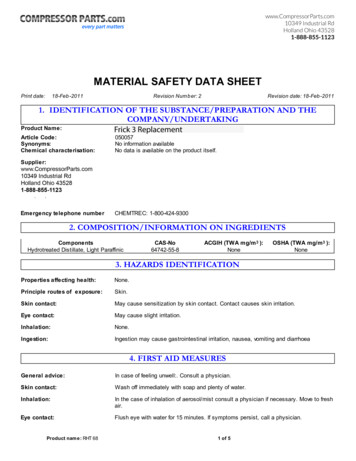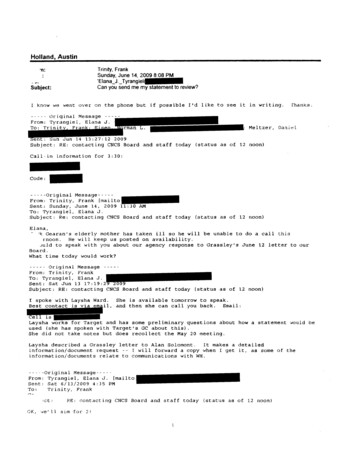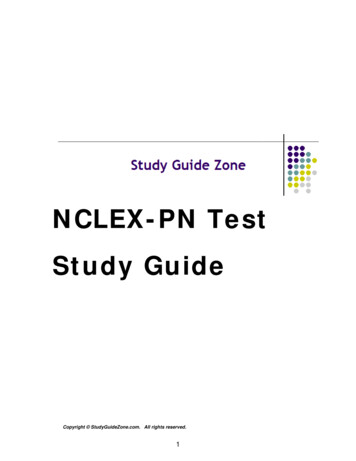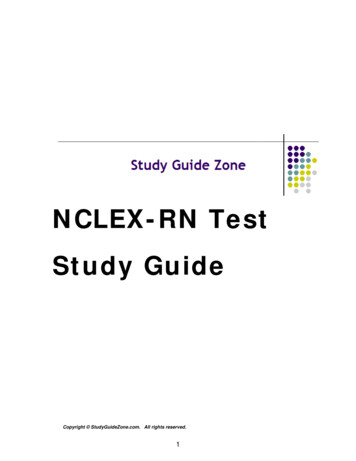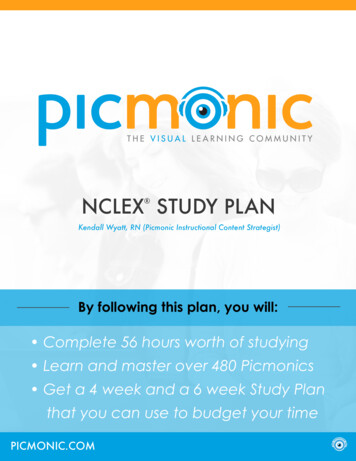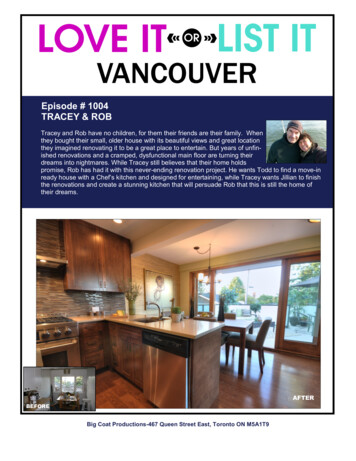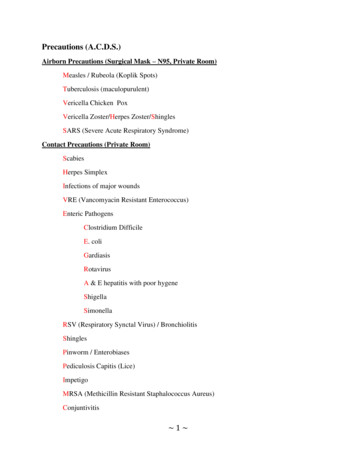
Transcription
Precautions (A.C.D.S.)Airborn Precautions (Surgical Mask – N95, Private Room)Measles / Rubeola (Koplik Spots)Tuberculosis (maculopurulent)Vericella Chicken PoxVericella Zoster/Herpes Zoster/ShinglesSARS (Severe Acute Respiratory Syndrome)Contact Precautions (Private Room)ScabiesHerpes SimplexInfections of major woundsVRE (Vancomyacin Resistant Enterococcus)Enteric PathogensClostridium DifficileE. coliGardiasisRotavirusA & E hepatitis with poor hygeneShigellaSimonellaRSV (Respiratory Synctal Virus) / BronchiolitisShinglesPinworm / EnterobiasesPediculosis Capitis (Lice)ImpetigoMRSA (Methicillin Resistant Staphalococcus Aureus)Conjuntivitis 1
Droplet Precautions (Private Room)DiptheriaRubellaRoseola / Erythema SobitumFifth‟s Disease / Erythema Infectiousum / ParvovirusPertussis / Whooping CoughPneumoniaInfluenza / EpiglotittisMeaslesMumps / Parotitis / Paroxymyx VirusScarlet FeverStaphalococcus PneumoniaStandard Precautions (Private Room)HepatitisAIDSInfectious Mononeucleosis / Kissing DiseaseLegionnaires Disease (Opportunistic: Need dedicated equipment in room)STD‟s (Gonorrhea, Syphilis, Chlamydia)Lyme DiseaseEczemaPCP (Pneumocystic Carnii Pneumonia) (Opportunistic: Need dedicated equipment inroom)PsoriasisTinea CapitisKarposi‟s Sarcoma (Opportunistic: Need dedicated equipment in room)Rocky Mountain Spotted Fever 2
Airborn Precautions – Droplet organism very tiny capable of staying in air to infect others.1. Private Room, negative pressure, vent outside of building, 6-12 air exchanges, UVLight,Door Closed2. Wear N95 mask when entering room, particulate respirator mask, surgical mask.3. When client leaves room client wears surgical mask.4. Cohort only with same organism.5. PPE when necessary.Contact Precautions – organism acquired by touching.1.2.3.4.Private RoomGloves & Gown when in contact with clientPPE when necessary.Cohort only with same organism.Droplet Precautions – large droplet organism infects only within 3-6 feet.1.2.3.4.5.Private Room, Door open, OK.Wear mask when entering room.Client wear mask when leaving room.Cohort only with same organism.PPE when necessary.Standard Precautions – promotes hand washing and use of PPE (eg mask, eye protection &gown) when appropriate for client.Apply to all blood and body fluids, non intact skin and mucus membranes.Use needless devices when appropriate, dispose of sharp instruments in puncture proofcontainer.Don‟t recap dirty needles. Clean all blood spills with bleach. 3
Antipsychotics / NeurolepticsEnd in “ine”A neuroleptic is used to treat arilOlanzepineStellazine, Seroquel, SerintilSx: Anticholinergic – Dry symptoms, dry eyes, blurred vision, constipation, urinary retention.TE: Increase fluids, increase fiber, increase exercise.Can cause blood dyscrasia – sore throat, fever, malaise, bleeding.AE:PhotosensitivityOrthostatic HypotensionBlood DyscrasiaAnticholinergicGalactorrheaEPS – Extra Pyramidal SymptomsPseudo ParkinsonianAkathesia – inability to remain motionless (constantly moving)Dystonia – tortion or twisting of body parts.Tardive dyskinesia – tounge slapping, inability to perform voluntary musclemovements.EPS Fever NMS (Neuroleptic Malignant Syndrome)Causes are sudden decrease or change in THIRMOS drugs. 4
Tx:AkinetonParlodelArtane (trihexyphenidyl HCl)CogentinKemadrin 5
Anti DepressantsTricyclic AntidepressantsTofranilAnafranilProzac – not a rthostatic HypotensionBlood DyscrasiaAnticholinergic (most common)MAOIParnateNardilMarplanTE: Avoid foods rich in tyramine. Processed foods, cheese except cottage cheese, papayas,bananas, avocados, alcohol.Sx:HeadacheHTNTachycardiaN&VAE:Vomiting, Anorexia, Nausea, Diarrhea 6
SSRIPaxilProzacSerzoneZoloftAnti-alytic / Anti-anxietyValiumAtivanLibriumXanax / AlprazolamAnti-manicLithiumGiven for Bipolar xiaPolyuriaTx: increase sodium, increase fluids, take oral contraceptives, do not use diuretics. 7
TB HepatotoxicRifampinInh – take with B6 to prevent peripheral neuritis.Pyrazinamide – PZAElivilStreptomycin – (both nephro and ototoxic)Drugs that turn urine red/orangeDilantinRifampinMacrodentinPyridiumPPD – Acid Fast Bacilli Test for TB has to be positive 3x. Check results 48-72 hours later.WhealIndurationSwellingElevationSx: TBMaculopurulent Sputum (bloody sputum)AnorexiaNight SweatsGeneralized Weakness / FatigueLow grade fever 8
Hepatotoxic DrugsPsychoticsAnticoagulants*S anti-seizureTB MedicationsAcetamenophen / TylenolL anti-LipidsAlcohol & pirinPlavixSigns of Liver Toxicity / HepatotoxicityJaundicePururitisPale colored stoolsSteatorrheaDark colored urine 9
Respiratory DrugsAnticholinergics – block parasympathetic nervous response.Atrovent / Inatropin ervousnessBeta Receptor Agonist “EROL” ending.Metaperenerol (Alupent)Albuterol (Proventil, Venteril)Levalbuterol (Xopenex)Terbutaline (Brethine) – given to pregnant women to delay labor.Broncho Dialators – give before ADL‟sTx: activity induced asthma (xandine drugs)AminophyllineTheophylline (10-20 is therapeutic range), take with food. 10
Glucocorticoids (inhalers)BeclamethasoneFluconasoneTE: If no spacer then 1-2 inches from mouth. If spacer, then make sure they have a tight seal.Rinse mouth after each dose to prevent thrush. (Cushing Symptoms).Leukotriene inhibitorsTE: Take daily dose at HS (Bedtime)Montelukast (Singulaire)Zafirlukast (Accolate)Mast Cell StabilizerCromylin Sodium (Intal) – Not effective during onset of asthma attack. Maintenance dosefor COPD and Asthma.Patients with COPD need daily Peak Flow Rate.Green Zone 80-100%Yellow Zone 60-80% - pt needs to take meds within 2-3 hours then call M.D.Red Zone less than 60%, take meds then go to ER. 11
HIV AIDSViraimmune – take on time “Do Not Skip”AZT “Retrovir” take on empty stomach.Vivacept “use contraceptives” (causes birth deformities)GancyclovierAcyclovirZidovidine – “ZVD” to prevent neonate transmission. Given after 14 weeks gestation. IVduring labor and in the form of syrup to neonate for 6 weeks after delivery.Patient can deliver natural childbirth but cannot breast feed. Patient cannot receive live vaccines(ex OPV, MMR)HIV Test to confirm infection:ELISA – Enzyme Linked ImmunoSorbent Assay – A single reactive result does notconfirm alone. Need a second ELISA.Western Blot / IFA – Test for the presence of antibodies.CD4 (lymphocyst) count – Above 400 not concerned, Below 400 concerned.Viral load testing – measures the presences of HIV viral genetic material “RNA”TE:No fresh fruitNo fresh flowersNo raw meatsStay away from cat litter “toxoplasmosis”Stouvadine (D4T Zerit) is used for patients that don‟t respond / tolerate conventionaltherapy.AE: Peripheral Neuropathy, Monitor gait, Add paresthesia. 12
Respiratory Ventilators – Causes of Ventilator AlarmsLow PressurePatient stops breathing spontaneouslyDisconnection or LeakLeak in the vent or patient airway cuffHigh PressureIncreased secretions or mucus plugWheezingEndotracheal tube displacementH20 in the tubeKink in the tubePatient biting, coughing, or gagging on the tube.Anxiety or fighting vent.Modes of Ventilation:SIMV – Synchronized Intermittent Mandatory Ventillation – Allows patient to breathe ontheir own between ventilator breaths. (Ex. 8 breaths from patient, 8 breaths from vent).Used to wean patient off of ventilator.Assist Control – most commonly used mode. Ventilator is breathing for client if clientdoes not initiate breath.PEEP Positive End Expiratory Pressure – to prevent closure of alveoli. Keep them opento prevent atelectasis.Controlled Ventilation (CV) – clients who are unable to initiate a breath . GB, TB, Polio,Total dependence on ventilator setting. 13
Forms of O2 Masks:Non-rebreather mask – provides increased concentration of O2 90-100% on expiration.Bag does not deflate.Ventri Mask – delivers concentrated form of O2 40-60%. Used for short termemergencies. 14
Renal System and DrugsNephrotoxicAminoglycosides “Nycin”Dye IV (angiogram)AntifungalContraindicated in Renal FailureACE Inhibitor – check creatinineAldactone – check K MOM – check Mg Dialysate Solution ctrolytes 15
Renal Drugs1. Colace (laxative)2. Drugs to lower Phosphorus ( Calcium)Renagel (Sevelormer)Os-cal (Calcium Carbonate) – Take with meals.Phoslo (Calcium Acetate) – Take with meals.Aluminum Oxide (Amphogel) – Take with meals.Colace (Stool Softener3. Drugs for Anemiaa. Procritb. Epoeiten (Epogen)c. Folic Acidd. Feosol (Iron)4. To Prevent GI Bleedinga. H2 Blockers5. Drugs for UTI / Cystitisa. Bactrim (Sulfa /TMT)b. Fluro-quinolone (Ofoxacin)i. Levofloxacinii. Ciprofloxacinc. Macrodentind. Pyridium6. Drugs for ICP patientsa. Mannitolb. Steroids with anti-ulcerc. Anti – Seizure meds (See 11 Neuro Drugs)7. Drugs for Renal Transplanta. Steroids – for lifeb. Immunosuppressantsi. Imuran (Cyclosporine)8. Drugs for BPH (Benign Prosthetic Hyperplagia)a. Flomax (Tamsulosin) – Take with a full glass of water.b. San Palmetto / Saw Palmettoc. Alpha Receptord. Proscar9. Drugs contraindicated for BPH (Benign Prosthetic Hyperplagia) Patientsa. Anticholinergicsi. Atropineii. Probantine / Ditropanb. Antihistamines (nasal decongestants) with pseudophedrine. 16
Urinary Diversion TechniquesIleal ConduitNo risk for fluid and electrolyte imbalanceContinuous drainageDrain bag needed @ all timesStoma CareKoch PouchInternal Ileal ConduitSelf Catheter, bladder trainingNeobladderNephrotomyConnected directly to kidneyContinuous drainageIn AM attach “saddle” bags, pouch attached to thigh.In PM drain into foley bag during HS. 17
TPNContents of 20HeparinAmino AcidsMineralsComplications of TPN:1. Air Emboli related to tubing / disconnection of tubinga. Tx: Clamp tubing, place on left side lying and call M.D.2. Pneumothorax - Puncture from insertion of central line.3. Infectiona. Tx: To prevent use sterile dressing site change q 48hb. Solution IV tubing change q 24h4. Hyperglycemia – Dry and Hot Give a Shota. Causesi. Infusion of TPN too rapidlyii. Not enough insuliniii. Infectionb. Tx:i. Slow infusion rateii. Administer regular insulin5. Hypoglycemia – Cold and Clammy Give Some Candya. Causesi. Abrupt discontinuation or too much insulinb. Tx:i. flow of TPNii. Run D10Wiii. insulin6. Hypervolemia – Fluid overloada. Tx:i. TPN Flow Rateii. Administer diuretics 18
Neurological DrugsLearn Neurological Disorders and their symptoms (Parkinson‟s, Guillian Barre, ALS,MS).1.2.3.4.MannitolSteroids “Sone”Antacids, PPI (Proton Pump Inhibitor), H2 Blocker, PGI (Prostiglandin Inhibitor)Anti-seizure Meds – Cause blood dyscrasia (sore throat, fever, bleeding, malaise).a. Benzodiazepinesi. Valiumii. Ativaniii. Libriumiv. Xanax / Alprazolamv. Clonazepamb. Depakote (Valproic Acid)c. Carbamazepine (tegretol)d. Kepprae. Neurontinf. Dilantin (Phentoin)g. Lamictal5. SCI (Spinal Cord Injury) drugsa. Stool Softenerb. Muscle Relaxants (VALX)c. Steroids “Sone”6. Anti-hypertensives – for autonomic dysreflexiaa. Isosorbide Dinitroleb. Isosorbide Mononitratec. Nitro (Paste)d. Nitro (Patch)7. Antiviral (encephalitis)a. Acyclovir8. Anticholinesterase (MG)a. Neostigmineb. Pyridostigminec. Physostygmined. Edrophonium Chloride (tensilon) – Test for MG.i. In MG, muscle strength will improve immediately after injection oftensilon.9. Atropine Sulfate – cholinergic crisis10. Anti Parkinson Drugsa. Levadopab. Amantidine (Symmetrel)c. Carbidopa (Sinemet)d. Comtane. Eldepryl 19
11. Anti EPS (Extra Pyrimidal Symptomes)a. Akintonb. Parlodelc. Artane (trihexyphenidyl HCl)d. Cogentine. Kemadrin12. Drugs for MSa. Steroidsb. Muscle Relaxantsi. Baclofenii. Valiumiii. Flexoriliv. Soma 20
Neurological Disorders (GB, ALS, MG, MS, Parkinsons)Guillain-Barré Syndrome (GB)Acute infectious neuritis of the cranial and peripheral nerves.Recovery can take yearsReversibleNurDx:Impaired breathing pattern.Ascending paralysis (starts from the lower extremities and goes up)Sx:ParesthesiaWeakness of the lower extremitiesProgressive weakness of the upper extremities and facial musclesTx:Monitor respiratory statusMonitor for autonomic dysreflexiaMonitor for impaired mobilityMonitor cardiac statusAssess for gag reflexAvoid infectionPlasmaphoresis, immunoglobulinPrepare to initiate respiratory support (02, ventilation, incentive spirometer).Amyotrophic Lateral Sclerosis (ALS)Lou Gehrig‟s DiseaseProgressive degeneration of the motor system that causes muscle weakness and atrophy.IrreversibleNurDx:Impaired Respiratory PatternSx:Difficulty chewingDysarthriaDysphagiaDysphoniaTongue AtrophyWeakness of the hands and feetTx:Monitor respiratory statusMonitor for autonomic dysreflexiaMonitor for impaired mobilityMonitor cardiac statusAssess for gag reflexAvoid infectionPlasmaphoresis, immunoglobulinPrepare to initiate respiratory support (02, ventilation, incentive spirometer). 21
Myasthenia Gravis (MG)Not enough acetylcholine at the myoneural junction. Defect in the transmission of nerveimpulses (Acetylcholine is the excitatory impulse).Dx: Impaired breathing r/t respiratory paralysis and failure. (Decending disease).Sx:DiplopiaDysphasiaDifficulty ChewingDifficulty BreathingDiminished Breath SoundsPtosisWeaknessWeak Hoarse VoiceFatigueTx:Monitor respiratory statusMonitor for autonomic dysreflexiaMonitor for impaired mobilityMonitor cardiac statusAssess for gag reflexAvoid infectionPlasmaphoresis, immunoglobulinPrepare to initiate respiratory support (02, ventilation, incentive spirometer).Multiple Sclerosis(MS)Demyelenation of the neurons. Chronic progressive disease of the CNS. Sensory Motor loss.Dx: Potential For I
3 Airborn Precautions – Droplet organism very tiny capable of staying in air to infect others. 1. Private Room, negative pressure, vent outside of building, 6-12 air exchanges, UVLight,File Size: 544KBPage Count: 61

